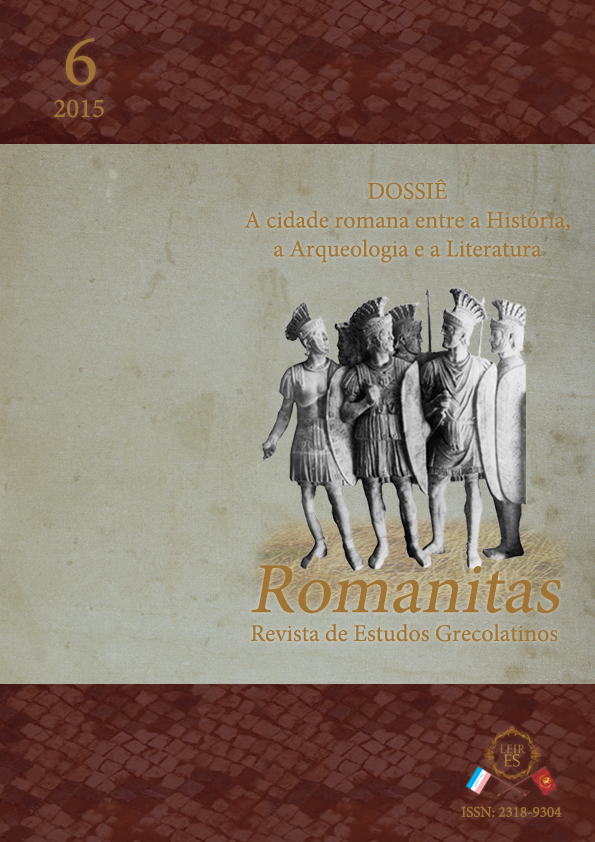Uma nota a Catulo 8 e 58: a fragmentação do 'ego' e a vulgarização de Lésbia
DOI :
https://doi.org/10.17648/rom.v0i6.11975Mots-clés :
Catulo 8, Catulo 58, Ego plurívoco, Lésbia, VulgarizaçãoRésumé
Um aspecto diferencial da poética de Catulo, que será seguido por outros poetas, é a utilização de seu próprio nome em sua poesia, apresentando-o um ego “plurívoco” como foi mostrado por Greene (1995), isto é, esse ego pode emergir da poesia na primeira pessoa do singular ou plural, na segunda pessoa do singular ou na terceira pessoa do singular. Esta suposta “inconsistência” gramatical não indica um uitium elocutionis contra a puritas ou a latinitas do discurso poético, ao contrário, deve ser lida como uma uirtus poética que é operada na estrutura argumentativa da coleção, ainda que possamos identificar nesse corpus um único livro, ou três. Este artigo tem o objetivo de aferir como podemos ler este fato linguístico em função de uma estrutura argumentativa que visa a sustentar o desenho da persona poética Lésbia na narrativa da coleção de Catulo.
Téléchargements
Références
ALLEN, A. W. Sincerity and the Roman elegists. Classical Philology, n. 45, p. 145‑60, 1950.
DYSON, M. Catullus 8 and 76. Classical Quarterly, v. 23, n. 1, p. 127-143, 1973.
FEAR, T. The Poet as Pimp: Elegiac Seduction in the Time of Augustus. Arethusa, v. 33, n. 2, p. 217-240, 2000.
______. Propertian Closure. In: ANCONA, R.; GREENE, E. (Eds.). Gendered Dynamics in Latin Love Poetry. Baltimore: The Jonhs Hopkins University Press:13-40, 2005.
FITZGERALD, W. Catullus and the Reader: The Erotics of Poetry. Arethusa 25, p. 419-43, 1992.
______. Catullan Provocations. Lyric Poetry and the Drama of Position. Berkeley: University of California Press, 1996.
GAISSER, J. H. Catullus. London: Blackwell, 2009.
GREENE, E. The Catullan Ego: Fragmentation and the Erotic Self. American Journal of Philology, v. 116, n. 1, p. 77-93, 1995.
______. Gender Identity and The Elegiac Hero In Propertius 2.1. Arethusa, v. 33, n. 2, p. 241-261, 2000.
GRIFFIN, J. Augustan Poetry and the Life of Luxury. Journal of Roman Studies, v. 66, p. 87-105, 1976.
______. Latin Poets and Roman Life. London: Duckworth, 1985.
GUNDERSON, E. Catullus, Pliny, and Love-Letters. Transactions and Proceedings of the American Philological Association, n. 127, p. 201-231, 1997.
LYNE, R. O. A. M. The Latin Love Poets: From Catullus to Horace. Oxford: Clarendon Press, 1980.
MARTINS, P. Breve história da crítica da Literatura Latina. Classica, v. 21, n. 2, p. 189-204, 2008.
______. Elegia Romana: Construção e Efeito. São Paulo: Humanistas, 2009.
______. Rumor, lei e elegia: considerações sobre Propércio 2.7. Archai, 2015b. Em edição.
______. Sobre a metapoesia em Propércio e na poesia erótica romana: o poeta rufião. Classica, 2015b. Sob referee.
______. O jogo elegíaco: fronteiras entre a cultura material ou intelectual e a ficção poética. Nuntius Antiquus, 2015c. Sob referee.
MUSE, K. Fleecing Remus’ Magnanimous Playboys: Wordplay in Catullus 58.5. Hermes, v. 137, n. 3, p. 302-313, 2009.
ROWLAND, R. L. ‘Miser Catulle’: An Interpretation of the Eighth Poem of Catullus and Catullus. Greece and Rome, v. 13, n. 1, p. 15-21, 1966.
SKINNER, M. Catullus 8: The Comic ‘Amator’ as ‘Eiron’. Classical Journal v. 66, n. 4, p. 298‑305, 1971.
WISEMAN, T. P. Catullus And His World. A Reappraisal. Cambridge: Cambridge University Press, 1985.
Téléchargements
Publiée
Comment citer
Numéro
Rubrique
Licence
© Romanitas - Revista de Estudos Grecolatinos 2016

Ce travail est disponible sous licence Creative Commons Attribution - Pas d'Utilisation Commerciale - Pas de Modification 4.0 International.
a. L’Auteur mantient les droits d’Auteur et accorde à la revue le droit de première publication.
b. L’Auteur a l’autorisation pour assumer des contrats additionnels séparément, pour distribution non exclusive de la version du travail publiée dans cette revue (ex.: publier en répertoire institutionnel ou comme chapitre de livre), avec reconnaissance de l’Auteur et publication initiale dans cette revue.
c. L’Auteur a l’autorisation et est encouragé à publier et distribuer leur travail en ligne (ex.: dans des répertoires institutionnels ou dans votre page personnelle) après la première publication par la revue, avec les créances.
d. Les textes de la revue sont publiés sous Licence CC BY 4.0 Deed Attribution 4.0 International (CC BY).




























